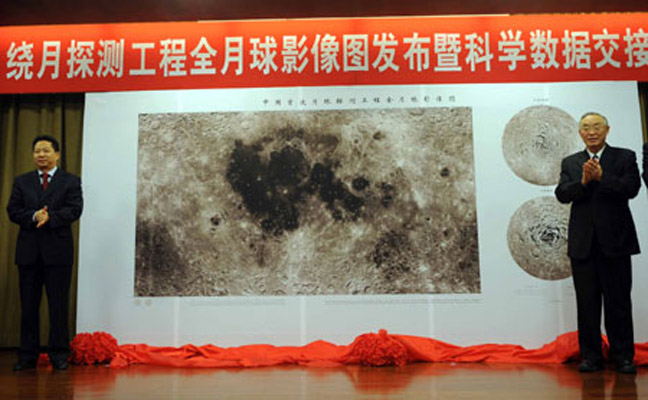Difference between revisions of "November 13, 2008"
| Line 6: | Line 6: | ||
<em>image from [http://news.xinhuanet.com/english/2008-11/12/content_10347379.htm China View]</em><br /> | <em>image from [http://news.xinhuanet.com/english/2008-11/12/content_10347379.htm China View]</em><br /> | ||
<br /> | <br /> | ||
| − | China is very proud of its lunar orbiter, Chang'e 1. Its [ | + | China is very proud of its lunar orbiter, Chang'e 1. Its [[November_27,_2007|China Daily]], the Chang'e map has a resolution of 120 m, considerably better than the <em>Clementine Atlas</em> 200 m. Hopefully, both of these maps will be bettered soon with the higher resolution imaging of the Japanese, Indian and American lunar orbiters. Based on the brightness of ray craters Tycho, Copernicus and others, this mosaic is like the Clementine one in depicting much of the surface (apparently between about 50°N and 50°S) under full-Moon lighting conditions, with progressively lower illumination toward the poles. For multispectral mapping to determine compositions of the surface such high lighting is excellent, but it is of less use in studying lunar topographic features. Apparently, the Japanese Kaguya orbiter is mapping the entire Moon at Sun angles of 10°-20°, which will be an excellent complement to the Chang'e map. The map was presented to the National Museum of China and there is no information of when it will be released to the world. So far we only have a news photographer's snapshot of this great achievement.<br /> |
<br /> | <br /> | ||
<em>[mailto:tychocrater@yahoo.com Chuck Wood]</em><br /> | <em>[mailto:tychocrater@yahoo.com Chuck Wood]</em><br /> | ||
Latest revision as of 22:26, 22 March 2015
Snapshot Map

image from China View
China is very proud of its lunar orbiter, Chang'e 1. Its China Daily, the Chang'e map has a resolution of 120 m, considerably better than the Clementine Atlas 200 m. Hopefully, both of these maps will be bettered soon with the higher resolution imaging of the Japanese, Indian and American lunar orbiters. Based on the brightness of ray craters Tycho, Copernicus and others, this mosaic is like the Clementine one in depicting much of the surface (apparently between about 50°N and 50°S) under full-Moon lighting conditions, with progressively lower illumination toward the poles. For multispectral mapping to determine compositions of the surface such high lighting is excellent, but it is of less use in studying lunar topographic features. Apparently, the Japanese Kaguya orbiter is mapping the entire Moon at Sun angles of 10°-20°, which will be an excellent complement to the Chang'e map. The map was presented to the National Museum of China and there is no information of when it will be released to the world. So far we only have a news photographer's snapshot of this great achievement.
Chuck Wood
Related Links
Sparse details on Chang'e-1 science instruments
Yesterday's LPOD: Platoization
Tomorrow's LPOD: A Rim?
COMMENTS?
Register, Log in, and join in the comments.



